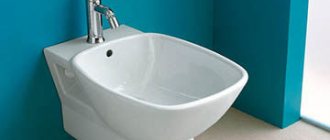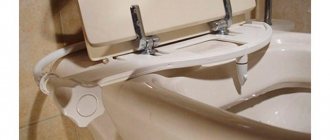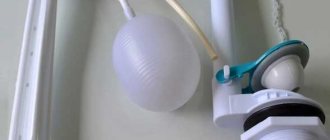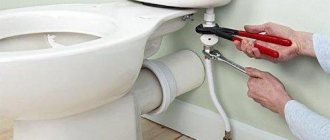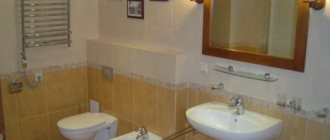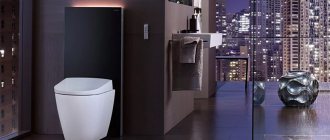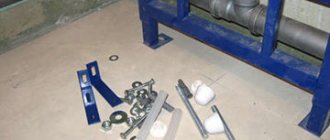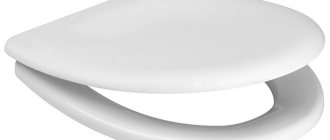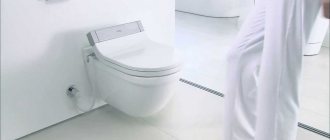- Some features and requirements
- Classification depending on the type of installation
- Children's toilets
- Bidet
Currently, apartment buildings are increasingly being delivered without any finishing, and plumbing fixtures are also not installed. The developers explain this by saying that the owners are invited to do everything to their own taste. Of course, this statement is partly true. But if you decide to choose your own plumbing fixtures, then you should pay attention to many parameters. So, for example, the dimensions of the bidet and toilet are important, as well as their appearance and the constituent elements from which they will be made.
Bidet and toilet
In any case, the plumbing equipment is required to be comfortable for each member of your family and, of course, fit into the dimensions of the room. Even before you go to a plumbing store to buy a new toilet, you should carefully select the location for its subsequent installation. It is necessary to provide the most comfortable conditions for subsequent use of the equipment. So, for example, it is required that the posture be as free as possible, and also that no part of the body rests against the walls or the door. At the same time, it is necessary to remember that there should not be too much free space.
Types of bidets
By installation method
- Floor-standing. Easy to install. To install the structure, it is enough to connect it to the cold/hot water supply and remove the sewer drain. The bowl is fixed to the floor using fasteners that are included in the kit. In some cases, you simply need to secure the bowl with glue or silicone. You can consider the options for floor bidets in our catalog; their selection is quite diverse. The advantages of floor-standing bowls are ease of installation, safety and ease of use.
- Hanging. Mounted using an installation system. The bidet is mounted on a special metal frame, which is fixed in the wall behind the trim; the wiring and drain are also hidden there. Not all manufacturers include installation in the kit; often the frame has to be purchased separately. A wall-mounted bidet requires a solid wall to install. Drywall and thin partitions will not support the weight of the plumbing. But for walls with average load-bearing capacity (foam, gas blocks), you can choose an installation whose design will partially shift the load from the device to the floor.
A wall-mounted bidet requires a solid wall to install. Drywall and thin partitions will not support the weight of the plumbing. But for walls with average load-bearing capacity (foam, gas blocks), you can choose an installation whose design will partially shift the load from the device to the floor.
The advantage of hanging bidets is that they save space. They increase the usable area of the room and look very interesting, giving the room a touch of exclusivity.
Other types
- Bidet attachment. Suitable for a very small bathroom. The device is made in the format of a lid, is quite functional, is mounted instead of a toilet lid, and is connected to the water supply and electrical networks. The lid is equipped with a nozzle that supplies water for hygiene procedures. Upgraded versions of the bidet lid have an electronic control unit, a heating element and even a built-in hair dryer - you don't need a towel.
- Hygienic shower. This is the most affordable option. The product is made in the form of a small mixer with a hose, at the end of which there is a miniature watering can with a lever/button for supplying water jets. The water temperature is controlled by a lever on the mixer. A hygienic shower does not have heating elements or a thermostat, so the temperature of the supplied water depends on the heating of the coolant. The mixer is connected to the water supply; it can be connected to a common system, sink or toilet. To install the shower head, a set of fasteners is included with the shower.
- Bidet toilet. This modified 2-in-1 device resembles an automatic toilet. The flush toilet is equipped with a shower system. Just press the button and the hygienic shower in the bowl extends to the desired position, and a stream of water is supplied from the sprayer. In improved samples, the intensity and temperature of the water are regulated. After the procedure, the hygienic shower “hides”, automatically cleaning itself.
What will you need for installation?
Before installation, you need to select a place where this piece of plumbing will be located. In order to worry less about problems and repairs, you should not close the water supply. It requires constant free access.
Installation Tools:
- Wrench;
- Tow;
- Adjustable wrenches;
- Screwdriver;
- Drill or hammer drill;
- Drill;
- Sealed composition.
You should have a connection diagram at hand. The bidet configuration uses an automatic drain valve (regardless of bidet model and type). There is no need to connect the structure to the siphon.
Floor-standing models are attached to the floor using special fasteners, just like a toilet. The liner is carried out using a tube and other elements. If the model includes a mixer, then it is better to install the bidet while changing pipes or connecting them.
Bidet installation
Installing it is very simple, you don’t need to be a jack of all trades, you just need to be able to hold the tool in your hands.
The procedure for installing and connecting the bidet is as follows:
- Assembling the faucet (done in the same way as for the sink faucet). Do not tighten it to avoid damage to the rubber layer and the tightness of the fastening;
- Installation of a flexible hose;
- Mixer mount. Studs and nuts are used for this. To avoid damaging the bidet material, use a rubber layer;
- We position the mixer in the center, tighten it with a wrench;
- We treat it with sealant so that nothing leaks;
- We fix the funnel to drain the water. This is done in the same way as installing a siphon for a regular sink;
- We combine the funnel with the hole in the bidet and apply sealant to the rubber gasket. We secure the gasket with a special ring;
- We assemble the bottom of the siphon and seal all the joints. We connect the corrugated hose to the general sewer;
- We install the bidet in the designated place and check the length of the hoses. If necessary, we adjust their size;
- We mark and also drill holes for fastenings with a drill;
- We put dowels in the fastening places and install a bidet. We secure it with bolts. A layer of rubber should be placed at the fastening points to prevent cracks from appearing in the material;
- We stretch the corrugation onto the drain pipe. We connect the tubes to the water. We coat all fasteners with sealant and wrap them with tow (tape for installation).
Installation with installation
This plumbing configuration consists of two items: a bowl and the installation itself.
Why is installation needed? The bowl rests on it and all communications and connections are hidden in this area. Bowl models can be varied. If a mixer is installed, this increases the functionality of the bidet almost to a mini-shower. Another configuration option involves installing electronic “stuffing”. Then the fountain can be adjusted. Some models even have a hairdryer for drying the skin and heating water.
It will be interesting: Method of installing a steam generator in the shower with your own hands
Installation process:
- We are preparing a niche for installation. Open the instructions and look for the installation dimensions in it. After that we make a niche;
- We supply pipes with hot and cold water;
- We make a connection. Before this, we install the installation, securing it in the corners (two to the wall above the bidet, two to the floor);
- We check with a level how evenly the frame is fixed;
- We fasten with fasteners from the kit. In order for the installation to hold more firmly, it can be reinforced at the bottom with a concrete solution;
- We connect the outlets to the sewer system. We attach water pipes to the bar, screw in the studs for the bowl, and secure the studs with locknuts;
- We sew up the resulting niche with plasterboard;
- We fasten the bowl and connect the entire structure to the water supply.
When connecting, you should check the quality of the connection, otherwise you will have to dismantle the bowl and start all over again.
When connecting, it is necessary to calculate the length of the pipe down to the centimeter, otherwise it will be difficult to connect it properly.
There should be a silicone (rubber) gasket between the bowl and the wall. Do not overtighten the nuts. This can cause the drywall to warp. And if the nuts are loosely tightened, the plasterboard structure will dangle.
Materials
Here everything is limited to sanitary ware and porcelain (ceramics). There is no fundamental difference between these materials. Outwardly, they are very similar, they are practically indistinguishable, since the sanitaryware is covered with glaze. If we compare the cost, then a bidet made of sanitary porcelain is more expensive due to complex production technology.
These materials differ only in the degree of porosity. It is larger in faience and less in porcelain. Since porosity determines the hygroscopicity of the material, porcelain models have good resistance to the formation of rust on the surface and the accumulation of dirt. A faience bowl will require more careful care.
In terms of durability, models made of sanitary porcelain win; they can last 50-60 years. For sanitaryware this figure is within 40 years. Manufacturers provide a 20-year warranty. It all depends on the quality of the product. We recommend not choosing the cheapest bidet, as they are made from low-quality earthenware and will require more frequent and labor-intensive maintenance as a result.
Minimum distance
If we talk about the minimum distance, then this value varies from 25 to 30 cm.
If the room is large, it is important not to “scatter” the appliances in different corners - the distance between the toilet and the bidet should remain comfortable regardless of the size of the room.
It should not be forgotten that both of these plumbing equipment form an integral functional complex , which is why they should be located nearby. It will be more difficult for those whose bathroom is too small, but still wants to install a bidet. It is considered incorrect in this situation to place the bidet too close to the toilet.
Types of faucets
Here everything is determined by the type of filling of the bowl: for models with external filling, any type of mixer is suitable, bowls with internal filling require the installation of a special tap.
To choose the right mixer, you need to consider several parameters.
Control type. Valve ones are old, but the most reliable due to their simplicity of design. Single-lever faucets regulate the water flow smoothly and quickly.
The most hygienic and convenient is a touchless faucet. It is equipped with a photo sensor that reacts to hand movements and turns on the water. The temperature is set in advance, it runs on a lithium battery.
The material determines the service life of the mixer and its type. Faucets made of bronze and brass are in demand. Products made from silumin and ceramics will last less, but will cost the client less.
Variety of designs and functionality
There's plenty to choose from here. A simple and very convenient faucet with a movable aerator regulates the direction of water. Models with a built-in thermostat automatically maintain the set water temperature. Improved devices deliver a jet of different intensities (soft, intense, pulsating, even saturated with air).
It is advisable to choose a bidet with a built-in heating element. Such a device will supply warm water even if it is turned off in the water supply network. This is important for city residents, where warm water is often supplied/disconnected on a schedule. It would be good if the model is equipped with a high side around the area with the tap. It will prevent water drops from dripping onto the floor.
Depending on the configuration, bidets may have additional options:
- heating water;
- drying function;
- seat heating;.
- massage functions;
- air purifier;
- backlight;.
For lovers of high-tech interiors and comfort, bidets are available with a micro-lift system, remote control, with an anti-dirt coating, an anti-splash function, drying, lighting, automatic adjustment of pressure, temperature of water and hair dryer air, with massage, a self-cleaning rod for hygienic washing, etc.
Room size
It is clear that a large bidet in a small toilet room will look too bulky. Therefore, it is necessary to initially select the right model, and for this you need to measure the room and draw a plan of this bathroom or toilet room on a scale. The drawing will help you understand where it is best to place the bidet. In this regard, it will be easier to choose its size.
During the development of the project, it is important to provide sufficient space in front of the plumbing so that the toilet and bidet are comfortable to use.
From each plumbing fixture to the wall in front of it there should be a minimum distance of 60 cm, while the optimal value is called 70 cm. You can always arrange the plumbing fixtures so that the most distant device is located 3 m away from the sewer pipe.
When planning, you should also consider how the toilet and bidet will look together. These plumbing fixtures are very similar, so for a more harmonious visual perception, you should select approximately similar options: in style, color and size. If you use a wall-mounted toilet, the bidet must also be purchased in a wall-hung version.
If the bathroom is shared, then the equipment should be placed so that the room is divided into separate zones, that is, a sanitary zone, where a toilet with a bidet will be placed, and a hygienic zone - a bathtub or shower stall and sink.
In addition, you can designate these zones, that is, separate them with partitions or different color flooring. You should also not forget about the place for the washing machine, if, of course, you decide to install it in the bathroom.
Design, shape and color
The white classic remains a hit. If the room requires accents on an unusual color of plumbing, then you can find an accessory in the desired tone: pink, light green, blue, black, chocolate brown, gold-plated, orange, bright red.
Today, decorated models with patterns, drawings on the bottom of the device, external cladding with mosaics of the same color or colored ones are popular. For a classic style, pearl white remains the best color.
For Japanese-style interiors, round-shaped sanitary ware in black design is installed. Dark bidet colors are also used for the bathroom in trendy minimalism. Models in contrasting designs, for example, black and white, red top and white bottom, look original. For country-style rooms, semicircular bowls in a light tone, decorated with a delicate pattern, are suitable.
